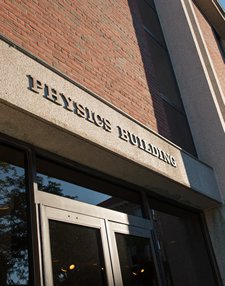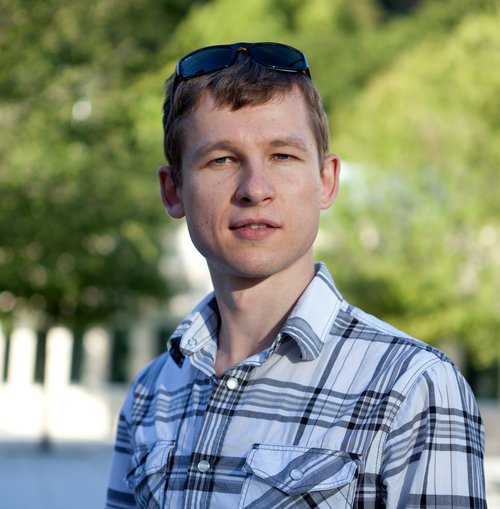
Although the Covid pandemic froze hiring in academic institutions the world over, our department has proudly welcomed multiple talented new faculty hires in the last six months. Two of these new professors, Mirna Mihovilovic Skanata and Ivan Pechenezhskiy, have been working to build both their homes and labs from scratch after moving to Syracuse. Their research interests of biophysics/neuroscience and quantum computing, respectively, are both promising frontiers of the field; perhaps even more interesting are the winding and often challenging paths Mirna and Ivan took to earn their positions in our department.

Mirna grew up in Split, a coastal city on the Adriatic and the second largest city in Croatia. A city built around a palace built for Emperor Diocletian in the third century, Split is a place uniquely influenced by the merging of antiquity and modernity; people still live in the palace to this day! Not only is the city architecturally and culturally unique, but it is also graced with a sporting talent that has achieved around one hundred Olympic medals. Mirna mentioned all of this when talking about where she grew up. It is easy to see how close her hometown is to her heart.
After high school, Mirna traveled to Zagreb, the capital of Croatia, to attend medical school. It was here that she was first exposed to scientists doing research, and she was inspired to become a researcher herself. Mirna was mostly intrigued by physics, neuroscience, and physiology, which she describes as physics of the human body. Mirna ultimately decided physics was the field for her, “I really liked how physics could explain something seemingly complex with just a handful of simple principles, so I studied to pass the entrance exams and enroll into a physics program.”
Enroll she did, earning her degree at the University of Zagreb where she studied particle physics. Mirna was even involved with an antimatter cell experiment, the goal of which was to test the viability of antimatter, with its higher energy payload when compared to ordinary matter, as a cancer treatment. For a brief moment, Mirna was a high energy biophysicist, a merging of two fields of physics often thought of as completely incompatible. While working at CERN, the particle accelerator in Switzerland and France, she decided she would pursue a PhD in physics.
Biophysics was not yet an established field in her home country of Croatia, so Mirna applied to Brown University where she joined a research group straddling the border between nanotechnology and biophysics. Mirna summarized her work at Brown impressively, “For my PhD, I designed nanopore devices to pass DNA back and forth and detect their electrical signatures, which in turn allowed me to test a longstanding theory of polymer physics that couldn’t be tested before.” She even patented a device that could contain DNA molecules, designed and built while earning her PhD.
Nanotechnology was not the only thing Mirna was mastering at Brown. After having grown up and attended college all in well-populated cities, Providence was quiet. This inspired her to pick up outdoor hobbies, so she learned how to sail and ski, both of which she still enjoys today. Mirna has carried this appreciation for the outdoors to Syracuse, where her and her family have been eagerly hiking and exploring all the trails and waterfalls of upstate New York.
After earning her PhD at Brown, Mirna pursued a postdoc at NYU. She was captivated by the work of Marc Gershow, who was striving to build a microscope that could image the activity of neurons in the brain of an animal that is moving around a sensory environment. Normally, to capture such an image the animal would have to be incapacitated or worse. Marc wanted to build a tracking algorithm that could predict where a neuron would travel, which would then keep the microscope trained on it. Mirna couldn’t pass up such an idea. She reflects about her decision to pursue this postdoc, “Looking back, both my PhD and postdoctoral advisors were young, energetic and, just having started their appointments, carried big ideas with them. I liked that a lot. So essentially, I switched my research direction completely as I started my postdoc.”
After her postdoc, Mirna applied to many institutions. So many, in fact, that she was travelling nearly every weekend for a span of months, until Covid made travel impossible. However, the Syracuse Physics Department and the people in it stood out to Mirna as a place that was welcoming, collaborative, and open to new ideas. She was especially intrigued by the BioInspired Institute, which connects Syracuse researchers at the interface of physics, engineering, and biology. Mirna also remembers seeing a sculpture displayed on campus by Croatian artist Ivan Mestrovic, a display she appreciated greatly. When Syracuse delivered on their offer a year later, delayed by the pandemic, Mirna remarked, “I was ecstatic.”
In her role as faculty in Syracuse, Mirna is aiming to understand the basic principles of how neural circuits orchestrate behaviors, giving us a new understanding of the core of living systems. “I will develop a microscope with a unique capability to read and manipulate the mind of a simple animal with cellular precision, to acquire circuit-level understanding of how brains encode behavioral tasks. Essentially, what this microscope will do is stimulate by using light a set of neurons in one part of the brain, simultaneously image the change in activity in a different set of neurons, all the while the animal is freely behaving.”

As Mirna has been working to set up her lab and research group to build this microscope, Ivan Pechenezhskiy has been hard at work in the sub-basement assembling equipment for his research into qubits, the quantum computing equivalent of bits for normal computers. Although he has risen to be an important name in the quantum computing world, Ivan comes from a part of the world few at Syracuse would be familiar with. Ivan grew up in Svobodny, Amur Oblast, a state in the far east of Russia that borders China. Amur Oblast has a population of under a million people, yet is roughly the same size as Germany. It comes as no surprise then that Ivan, at a very young age, wanted to be a farmer.
However, his first exposure to physics, engineering, and astronomy through documentaries on the Soviet space program and a popular Russian TV show Evident, but Incredible would lead him down a different career path. From there he read books on subjects like metallurgy and mechanical engineering that his parents brought home from the library of their factory that was shutting down. The last push for Ivan was a desire to see more of the world, and he knew he could get that by pursuing a career in science. This was perhaps the reason he decided to attend a specialized scientific high school that was a three and a half day ride west by train from his hometown of Svobodny.
After high school he continued pursuing the best education he could, and moved even farther west to the Moscow Institute of Physics and Technology (MIPT). It was one of the few places in Russia conducting cutting-edge research in the 90s, despite the economic and political challenges facing the Russian scientific community at the time. In Moscow, Ivan undertook research in the magnetoresistive properties of two-dimensional electron gas under microwave radiation. His reasons for pursuing this field of research? “While the buildings and most of the equipment were old, the occasional sights of the modern equipment spiked my curiosity. The idea of being in charge of the entire experiment, which is typical in condensed matter physics but sometimes rare in the other fields, was also very appealing.”
While working at Fermilab as a summer student who wanted to travel the world, Ivan decided he wanted to pursue his PhD abroad. A wager with a friend convinced him to apply to Berkeley, even though Ivan didn’t believe he could get in. Luckily for him, the price of losing that bet was just a 12 pack. At Berkeley, Ivan stayed in condensed matter but shifted slightly to work on scanning tunneling microscopy, a field that images surfaces at the atomic level. He recalls memories of a supportive advisor, frustration with a dead end project, perfect weather year-round, filling liquid nitrogen dewars late at night, and forging lasting friendships; almost all of which will be familiar to the average Syracuse graduate student.
After graduate school, Ivan continued to pursue an academic career, first with a postdoc at University of Wisconsin-Madison and then another at the University of Maryland. He continued to build his skills and expertise in these positions, which made him a valuable hire for Senior Quantum Engineer at Seeqc, Inc, a private company looking to build the first quantum computing platform for global businesses. Ivan decided to make the switch to the private sector because it was the most exciting opportunity at the time. He enjoyed the better work-life balance and pay of his new position, perhaps the two biggest reasons for academics to make the switch to industry. Ivan also noted that he had something rare for an industry job at Seeqc, “I was actually lucky to enjoy quite a lot of freedom there too.”
But the draw to a challenge was too much for Ivan. He knew establishing a research group of your own is a huge undertaking, and he had a few friends encouraging him to take the plunge. Back in 2019, after hearing about the position at Syracuse from a former post-doctoral advisor, he decided he would submit an application. Before he even sent the application, Ivan was contacted by a member of the job search committee. Despite enjoying his work and teammates at Seeqc, Ivan could not resist the test of building his own research group and decided not to pass the opportunity to start at Syracuse roughly a year later. The rest is history.
Once Ivan conquers his current challenge of assembling his lab, a process made more complicated by shipping errors and supply shortages, he will set about trying to address fundamental questions in quantum computing. He takes a very positive outlook on the situation, “The last couple years including the months at SU have been pretty good to me. I’m grateful for all the experiences and I am certainly seeing some fun in trying to deal with the issues I have zero control over. I do find joy navigating the obstacles.”
Like Mirna, Ivan is looking to theorize and engineer new technology to deepen our understanding of qubits. He plans on reducing the noise imparted on the qubit, therefore lengthening its functional lifespan, by testing new designs, alternative materials, and employing other mitigation strategies. Although this may sound somewhat mundane, one must remember these tests are being done incredibly close to absolute zero, or -460 degrees Fahrenheit. The theoretical knowledge and engineering infrastructure required to conduct experiments at these temperatures is immense.
Mirna and Ivan are in the process of building great research groups, and they have already proven themselves to be valued members of our community, improving both the science and climate of the department. They are both young and visionary researchers in their fields, and the fruit of their vision will be enjoyed by the students and faculty who get to work with them in the coming years. The physics department looks forward to seeing what Mirna and Ivan will accomplish!
